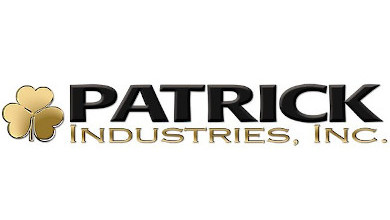Patrick Industries has reported its financial results for the first quarter ended March 31.
Net sales for the first quarter of 2019 increased $56.4 million, or 10%, to $608.2 million from $551.8 million in the same quarter of 2018. The increase in the first quarter was primarily attributable to acquisitions and organic growth, which was partially offset by double-digit declines in RV and MH industry wholesale unit shipments.
Patrick’s revenues from the RV industry, which represented 56% of first quarter 2019 sales, decreased 9% from the first quarter of 2018, compared to a 27% decrease in RV industry wholesale unit shipments, as estimated by the company.
Revenues from the MH industry, representing 17% of first quarter 2019 sales, increased 70% compared to the prior year with a decrease in MH industry wholesale unit shipments, as estimated by the company, of approximately 10% from the first quarter of 2018.
Patrick’s RV content per unit (on a trailing 12-month basis) for the first quarter of 2019 increased approximately 30% to an estimated $3,131 from $2,414 for the first quarter of 2018. MH content per unit for the first quarter of 2019 increased approximately 42% to an estimated $3,389 from $2,382 for the first quarter of 2018.
For the first quarter of 2019, Patrick reported operating income of $35.8 million, a decrease of 14%, or $6 million, from $41.8 million reported in the first quarter of 2018. Net income in the first quarter of 2019 was $20.8 million compared to $30.1 million in the first quarter of 2018.
“We are pleased with our first quarter performance as we continue to execute through significant wholesale unit shipment rebalancing in our primary RV market sector, and a housing sector that continues to be hampered by wet weather in the southeastern and certain western regions of the country, impacting both the MH and residential housing markets,” said Todd Cleveland, CEO of Patrick Industries. “In addition to the impact on our operating and net income in the first quarter of 2019 that resulted primarily from wholesale unit shipment declines in our RV and MH markets, our profitability was also negatively impacted in the quarter due to carrying higher priced inventory in a declining commodity pricing environment with softer than expected production levels. We anticipate continuing to work through the higher priced inventory through the second quarter of 2019.”
“RV and marine dealer sentiment remains positive and dealer shows and retail traffic are off to a solid start to the year,” said Andy Nemeth, president. “RV OEMs have continued to adjust their production levels through April as dealers have managed inventory weeks on hand over the past four quarters to better align with shorter delivery lead times resulting from OEM capacity increases. Based on the most recently available data, we anticipate that the industry is approaching a return to equilibrium in RV dealer inventories in the near term, which will position RV OEMs to be able to return to producing units more in tandem with expected retail demand, in particular as we head into the seasonally strong spring and summer selling seasons.
“Our diversified market presence in both marine and certain industrial sectors, where we outperformed the respective markets in the first quarter, has helped to offset the volatility in both the RV and housing markets,” Nemeth continued. “Favorable demographic trends and wage growth, a strong U.S. economy and jobs market, equity market strength, and strong consumer confidence levels all point toward long-term slow and steady growth in both our leisure family lifestyle markets and our housing and industrial markets.”
Effective Jan. 1, the company adopted, as required, the new lease accounting standard relating to operating leases, resulting in the recognition on the company’s balance sheet of short and long-term operating lease liabilities of approximately $80 million in the aggregate with a corresponding amount for right-of-use assets. Primarily reflecting the adoption of this standard as well as seasonal working capital needs, total assets increased $124 million to $1.4 billion at March 31 from $1.2 billion at Dec. 31, 2018. There was no impact on reported net income and net income per diluted share for the first quarter of 2019 from the adoption of the standard.
